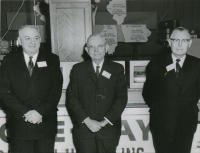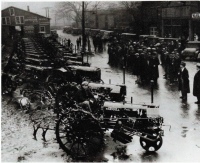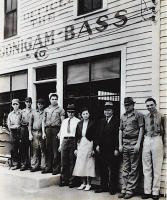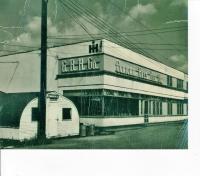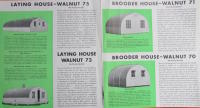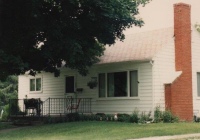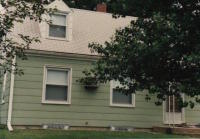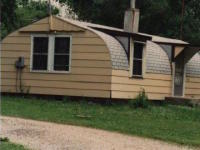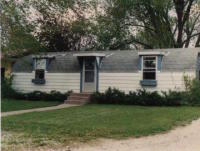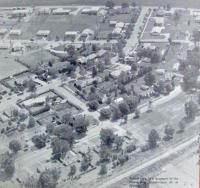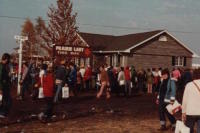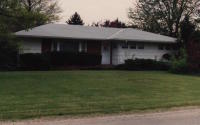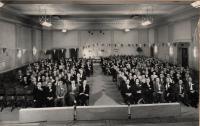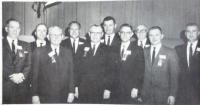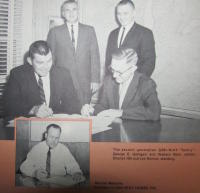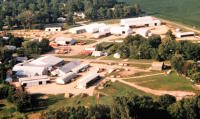History
A History and Legacy of GBH (Gonigam-Bass-Hill), Homola Homes, Homeway Homes, Walnut Custom Homes, and Walnut Custom Components in Walnut, IL
Every story has a beginning and this story begins with Peter Gonigam, who immigrated to the United States in 1850 from Metz, France. After arriving in the US, Peter became an apprentice in the manufacture of buggies and wagons in Milford Pennsylvania under a man named John Heller. He moved to Princeton, IL in 1860. He engaged in the manufacture of buggies and wagons and expanded into the manufacture of harrows, bob-sleds and other farm tools. On June 1, 1861, John Peter Gonigam was born in Princeton, IL and on June 13, 1868, his brother Louis Edmond Gonigam was born. Unfortunately, John Peter and his wife died early and that left a difficult life for George H. Gonigam (their son and one of the key figures in our story). After a challenging life to that point, George joined the service of his country in World War I.
In 1911, Mr. L. E. Gonigam Sr. (George’s Uncle) founded a feed, livestock, lumber and farm supply company in Walnut, IL. George H. Gonigam (nephew of L.E. Gonigam Sr.), after returning from World War I in September of 1920, became associated with L.E. Gonigam, Sr. as a partner in L.E. Gonigam’s supply business. Upon the retirement of L.E. Gonigam in January 1925, George H. Gonigam along with Glenn W. Bass (who had just graduated from the University of Illinois in engineering) formed the partnership of Gonigam Bass Company on the foundation of the old supply business. They continued to sell lumber products but also added coal, commercial feed for farm animals, and other farm-oriented products.
In approximately 1928, they hired a salesman by the name of Clifford Hill. In 1933, the Gonigam Bass Co. took on the International line of farm implements. Cliff was soon into the business of selling farm tractors and taking horses in trade. This became a staple of the farm trade with corrals of horses and mules accumulating. I remember my father George E. telling me about the corrals and having his pick of horses to ride. Cliff Hill was an impressive salesman and in 1936, Cliff was brought into the company, and the name was changed to Gonigam-Bass-Hill, Co.
About that same time, farmers were in need of brooder houses, farrowing houses and other small farm buildings in their operations. With Glenn Bass’ expertise in engineering, Cliff Hill’s sales ability, and George H. Gonigam’s expertise in the lumber business they began designing round-roof buildings to meet the farmer’s needs. These structures and a few other experimental homes were built in the old lumber shed on Jackson Street (across from the Walnut United Methodist Church).
During those years Gonigam-Bass-Hill Co. sponsored the WLS days with personalities (such as Minnie Pearl). In those days, WLS broadcast a farm format rather than the rock format and now talk radio format of later years that many of us are familiar with. WLS aired the farm show that would be held in Walnut. Most all of the “Old Timers“ around Walnut will remember these extravaganzas for the day with a line-up of tractors and other machinery all along the street. Free pancake and sausage meals were served in the repair shop for anyone who cared to come and eat. The pancake and sausage meals and open houses were sponsored to show off the newest in farm equipment and continued into the sixties at the succeeding farm shows.
In 1938, Gonigam-Bass-Hill Co. exhibited its first sample house designed by Willis at the lumber dealer’s convention in Chicago and in 1939 another plywood sample house built to Willis’ plans was shown at the Bureau County Fair in Princeton, Illinois. It measured 20 X 36, with two bedrooms. Two houses were sold and built from this show. It was also in 1939 that a young man came to Walnut with a degree in architecture from the University of Illinois. Eric Jauch, a die-hard fan of Frank Lloyd Wright, introduced some new ideas that changed the direction of Gonigam-Bass-Hill Co. for years to come. With this expansion of product and new ideas they needed more room.
On January 3rd, 1941, they purchased the Shearburn Lumber & Supply Company located just north of the railroad crossing on Main St, Red Oak Rd and Depot Street. This was converted into a plant for the prefabrication of houses and farm buildings. It would also later house the office of a new company that was formed and known as GBH Housing Company. The new company was primarily engaged in manufacturing and would be a separate enterprise from the retail business of Gonigam-Bass-Hill Co. Clifford Hill was the manager of the new company and Ormand Gerbitz was engaged as plant foreman. Harry Bolz and Everett Sarver, employees of Shearburn Lumber were retained as employees of the new company. New machinery was ordered, a sales program was set up and a builder-dealer or two enlisted. Panel sections which form walls, floors, ceilings, roofs of the GBH-Way houses were fabricated in the new plant. These sections could be quickly and easily erected on a building site by any contractor familiar with ordinary construction methods. Work in Walnut speeded up and in 1941 GBH-Way Homes was incorporated with George H. Gonigam, Glenn W. Bass and Clifford M. Hill as officers and GBH-Way Homes,, Inc. was in business. These homes were sold as a total prefabricated package. The package included plumbing, wiring, wallpaper and had a plywood skin construction. Construction time on this package was 5 days.
December 7th, 1941, changed all the best-laid plans of GBH with America’s entrance into World War II and the resultant clampdown by the War Production Board on materials and equipment. Between 1942 and 1945, the new company worked on government contracts for tenant-type houses in the Defense Housing Program; on portable farm buildings, prefabricated grain bins and on Army Ordnance commitments. One special permit was acquired when Cliff Hill went to Washington D.C. to convince the government that farmers who hired men to produce crops for the war effort also needed housing. By converting the various brooder and farrowing houses into living quarters GBH could fill a niche market that was good for the war effort. The resulting product was lovingly referred to as the Garden house. Hence it was not until 1946 that GBH-Way moved into large scale production of its prefabricated homes. Special attention went into the development of the new houses and a 40-acre tract was purchased of which some 15 acres were platted and incorporated into the Village of Walnut. This is now what is called the 40. It is along Depot Street you may find some of the early inspired homes of Mr. Willis and also another called the Homola Homes.
In 1945, GBH-Way Homes, Inc. sold the Homola, a Cape Cod house from the state of Washington. Toe to unavailability of material, GBH-Way bought these houses by the trainload and sold everything they could get their hands on. Construction was 4 x 8 panels with 2x2 studs & ½” Plywood interior and exterior. The frame was steel 4” OC. The floor was also steel frame 4” OC with 2x4” joist with ¼” Plywood on the bottom and 3/8” plywood on the top.
It was also this time period that saw the return of Wally Bass, Charles Hill and Francis Bangtson, all World War II veterans, and the start of the second generation at GBH-Way Homes. Within a few more years George E. Gonigam and Glenn R. Gonigam joined the companies in various positions. Both Gonigam-Bass-Hill Co. and GBH-Way Homes, Inc. flourished in the years to come with lumber, International Farm Equipment, Wayne Feeds, coal, farm buildings and prefabricated housing. It was during these developmental years that the Home-Way House, as it was then named, was fully developed. These second generation partners along with the company’s founding fathers had a vision that the entire corporate organization as well as its operation was embraced within a family enterprise. The junior generation, while not yet taking over, was being trained and groomed for that responsibility, and this included the workers at the plant as well. Cliff Hill, president, summed it up: “Regardless of family relationships there is that feeling of loyalty and closeness, of belonging, in the plant, in the office, and in the field that makes for efficiency in operation and quality in the manufactured product.” During this time, GBH developed a program where overalls bearing the GBH Letters were given to every child born in the Village of Walnut. This program ran during the late 1940’s and into the 1950’s. Many members of the Walnut community remember wearing these overalls and some have been passed down to current generations as reminders of this great success of the company.
Another turning point for the new GBH-Way Homes was its association with the Prairie Farmer Magazine. Their “Farm Progress Show” in IL, IA, and IN attracted 200,000 or more people. At about that time (1954), Les Renner joined the firm in marketing and design. The next year (1956) GBH-Way Homes was invited to have an exhibit at the show. Beginning in 1957 in Farmer City, IL. GBH-Way Homes was selected to build the first complete home (PLX99) on the grounds and have it completely finished and furnished for the three-day affair. The “Prairie Lady” home was to be built in the middle of a hay field with a tent city surrounding it with other farming related products. Who knew that thousands of people would go through this house and it would become a trademark of GBH-Way Homes for years to come.
In January 1961, George H. Gonigam, Glenn W. Bass and Clifford M. Hill semi-retired and a new management team took the reins of GBH-Way Homes. However, a look at the team roster made it clear that the company would continue to be a “family style” operation. The new vice-president of the firm was Wallace Bass, 41 year old son of Glenn Bass. Secretary-treasurer was George E Gonigam, 32 year old son of George H. Gonigam. The sales manager was 39 year old Charles Hill, son of Cliff Hill and Les Renner, son-in-law of Cliff Hill, as public relations spokesman and designer. Other members of the management team were President Norm Metcalf, 49 years old and a 19 year veteran with GBH-Way Homes. Eric Jauch, age 45, director of research and engineering and John R. McLane, AIA. This group also believed as the founders did that everything they did was based on a foundation of integrity and quality of product and as Cliff Hill said, “ We’ve all worked with these men long enough to have the “feel” of the GBH-Way of doing business and we’re convinced that it’s the only way of doing things”.
In 1965, GBH Way Homes celebrated their 25th anniversary with a booklet “Three Men and a Dream”. That same year, the partners of Gonigam Bass Hill Co decided to dissolve the old retail company name and was incorporated into “GBH Inc.”. This effort was made to combine the products and services of the lumber yard with the building services segment . Now appliances, carpet sales, and other home-oriented products allowed GBH Way homes to sell more complete packages to the dealers in the 4 or 5 adjoining states. This combination of operations proved quite successful and beneficial to the tax base in Walnut as well. The business continued with the “Prairie Lady” as the centerpiece of the operation. The following decade was highly successful and profitable.
As the market began to change and some management people retired as well, there was some interest by a company in Peoria to purchase the entire operation (both GBH Inc. and GBH Way Homes Inc. In the fall of 1977 an offer was made and accepted to sell the operations to Jobst Construction Co. of Peoria. A large successful company involved in primarily commercial construction. The new management took over in August of 1977 and re-organized the operation into a new company to be known as Homeway Corporation. Some partners retired, others changed positions, some moved on and a new office building was designed and built. The new office was a complete remodel and addition to the existing Gonigam Bass Hill building on Jackson Street (now the home of Walnut Community Bible Church).
Shortly after the purchase and reorganization, the double digit inflation and double digit interest rates came upon the U.S. industries. At this point, farmers stopped building new homes, developers in cities cut back on speculative building and high interest rates virtually stopped construction. It was perhaps the good fortune of the G, B, and H. families to have sold under the circumstances. The company name had changed to Homeway Corporation in 1977 reflecting the product name of the former company. But, 1980 brought a new era to the new company with virtually no new housing being built. The need to find new ways to continue was imperative. Jobst formed JDJ Co as a “sister” company of Homeway Corp and began development of apartment projects under HUD financing (one of the few sources of funding). Indianapolis became the center of some 3000 apartment units and the Homeway plant had to re-vamp their production to meet a different market. This market, while requiring different skills, managed to supply the operation with profits and a tax base for Walnut once again. When that market was completed in 1982, a new one opened up in Texas. Big oil companies funds were made available for apartment construction in Texas. The JDJ Company called for a move to Dallas and Homeway Corp. had to set-up a manufacturing plant and construction-arm in Dallas area and staff the offices and plants. Les Renner and several young men from Walnut moved there for a 2 year period. This resulted in building another 3000 units in the Dallas-Ft Worth area.
By the middle of 1983, interest rates had again spiraled out-of-site, the JDJ company had financial challenges, and the result was that Jobst, Homeway and the sister companies met their expected fate. Several members of the family-partners resigned and left in late 83 and early 1984. JDJ, Jobst, and Homeway Corp suffered final bankruptcy in the summer of 1984.
Now some of the employees of that corporation banded together and with a lot of effort they were able to keep that dream of George H. Gonigam, Glenn W. Bass and Clifford M. Hill alive. On June 29th, 1984, Walnut Custom Homes, Inc. was born. Certain properties and assets of Homeway Corp. were purchased and with the help of employees, friends, and community support WCH was able to produce a quality product while providing jobs and tax base. With the long holiday weekend WCH was able to get all the equipment in place and have product rolling out the door with delivery commitments being made. This was all done under the direction of: Wallace Bass, Chairman of the Board; George E. Gonigam, President; David Behrens, Vice President; Joan Watson, Secretary-Treasurer; and the following directors, Gary Erickson, Bonnie Kepner, Scott Gerbitz, and Ken Reschly who is a dealer from Olds, Iowa. George Gonigam commented that, “Much of the current economic recovery is attributed to new companies that are intent on management keeping overhead down and production high. WCH has been structured to fit that image.”
It was on that day in 1984 that WCH began production with 26 management and production employees. The general offices were temporarily located in the basement of Citizens First State Bank while production and storage was at the Plant II location on Liberty Street. The company planned to concentrate on high quality custom designed single family homes as had GBH-Way and Homeway. It was only through the tremendous efforts of the entire community that WCH was able to reach the launch pad and it was said, “The dream continues, we’re on the move.”
From those beginnings WCH evolved and began to expand its operations and production capacity. They branched out into multi-family units, hotels, and light commercial buildings such as Wendy’s, Taco Bell, and Culvers. Employee numbers rose into the fifties and low sixties as the company grew. All this was done with the involvement of George E. Gonigam (who passed away in 2005), Wally Bass and David Behrens. The business flourished until 2007-2008 when the home building business slowed to a virtual stop all over the USA. Sales of homes decreased in scope to the 1982-1984 era and they too had suffered slow markets in this economy. Charles Gonigam, the 3rd generation of the George H. Gonigam family assumed the leadership of WCH under the direction of the Board of Directors. Wally Bass was Chairman of the Board and handled the purchasing-inventory position until his death in 2011. The 6 years of setback in housing took its toll on the company. If it had not been for the generosity and hard work of the board members, employees, family, friends and the community of Walnut WCH would have failed.
In November of 2012, Les Renner (who had retired from other occupations) was brought into the company as interim CEO to evaluate the operation, work with the management team to reorganize and/or streamline efforts, and help locate a permanent President for the company. A new vision, business model and mission statement was established; and home building was starting to show strength. In April of 2013, a search was started for new investment in the company. The housing market was improving, the opportunity was growing, and it was determined that additional capital was needed to insure the survival and growth of WCH in the marketplace. Larry and Steve Gerdes (native sons and long-time supporters of Walnut) purchased the company with a commitment to investing needed funds and expanding the operation.
On October 1st, 2013, Walnut Custom Homes under new ownership updated the name to “Walnut Custom Components” to better represent the company’s expertise and focus. With all the changes WCC remains a business focused on delivering a quality product coupled with an emphasis on service to our customers. These qualities and values have defined the company since its beginning.
As we move forward, we can still recognize the blueprint of our founders. We owe our survival to them, their heirs, our new investors and many other supporters over the years. WCC continues to follow their values and work ethic established almost a century ago. We will continue to be the best at our craft and never be satisfied with, "that's how it's always been done". It is our job to challenge, encourage and empower those around us to make sure the vision of our past and present leadership lasts into the future.


